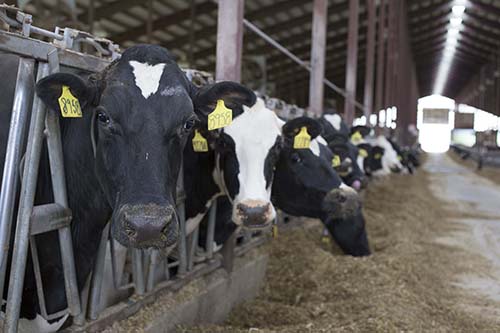
Farms getting 100 pounds of milk per day from their cows are doing a lot of things right. Like what, you might ask?
To answer that question, Nigel Cook and his colleagues at the University of Wisconsin School of Veterinary Medicine performed a cluster analysis of 557 dairy herds with more than 200 cows using freestall housing in Wisconsin. The analysis categorized farms using 16 different DHIA monitors of herd performance. The farms sorted themselves into six clusters of varying levels of production and herd health success.
Farms that had similar production levels and herd health statistics certainly did not do everything exactly the same, Cook explained. "We can get the same end result in a number of ways". There were some practices, however, that came to the top in many of the high producing, well cared for herds.
Cook shared the top practices that led to healthy, productive cows in their survey during his presentation at the Hoof Health Conference held in Brookfield, Wis., this month. They included:
- Great feeds and feeding.
- The use of safe, efficacious production enhancement technology. Most common technologies among the survey herds were 3 times per day milking, BST, and Rumensin.
- A sufficient number of high quality employees. The top farms had employees that were able to provide low stress handling, identify sick and lame cows and identify cows in heat.
- Manage lameness. "Lameness affects the way she behaves, acts and eats," Cook noted. Deep bedding, regular trimming, rubber floors in the parlor, properly run footbaths, some access to pasture, and fewer cows per worker were all common themes among the top producing herds.
- Get cows pregnant. "Yes, there are challenges but you can get high producing cows pregnant," Cook said. Their survey results showed that pregnancy rate was improved with less cows per inseminator, lower stocking densities and more heat abatement.
- Achieve above average fresh cow health. Herds with the best production provided adequate bunk space, a comfortable place to lie, low stocking density for transition and fresh cows and avoided regrouping cows one week prior to calving.
- Excellent udder health. "We must limit the amount of manure that contacts the teat," he said. "It's a challenge but not impossible." Farms with healthy, high producing cows kept teats clean and found cases of mastitis earlier.
- Pay attention to heat stress. "Heat really impacts cows in so many physiological and behavioral ways," Cook said. The use of fans, natural ventilation, soakers or a combination of the three aided in higher production.
"We can have our cake and eat it, too," Cook concluded. "We can have high-producing cows and take care of their health."

The author is an associate editor and covers animal health, dairy housing and equipment, and nutrient management. She grew up on a dairy farm near Plymouth, Wis., and previously served as a University of Wisconsin agricultural extension agent. She received a master's degree from North Carolina State University and a bachelor's from University of Wisconsin-Madison.








